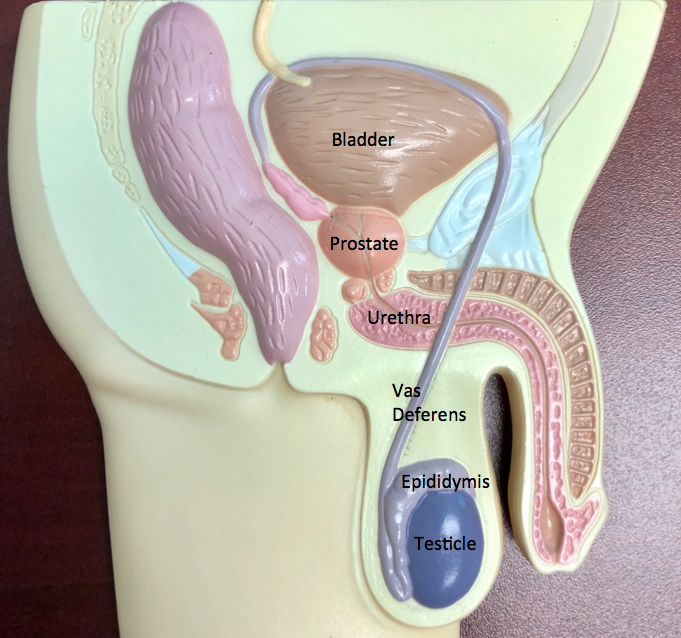Testicular Pain
Testicular pain Is a common condition that occurs frequently in men.
What does the testicle do? What are the other parts in the scrotum?
The male anatomy is shown in the following picture.

The scrotum is the name for the sac, and the testes and its adjacent structures sit inside the scrotum. The testicle has two functions. It makes testosterone, the male hormone, which is carried from the testis through the blood stream. It also makes sperm.
Sperm travels from the testicle into a series of tubes that form the epididymis. The epididymis sits to the side and in back of the testis. Sperm leaves the epididymis by way of the vas deferens (this is the tube that is divided during a vasectomy) and the vas deferens joins the seminal vesicles and prostate. The vas deferens travels through a structure known as the spermatic cord, which also includes the artery and vein that provide the blood supply to the testis, and the lymphatic vessels that drain the testis. Sperm delivered from the vas deferens, mixes with fluid from the seminal vesicle and prostate to produce the semen, which is the fluid that comes out from the penis at the time of ejaculation.
What can cause a lump in the scrotal contents?
A variety of conditions may cause a lump in the scrotal contents. This lump may be felt by the patient, or may be detected by a healthcare provider during a physical exam.
Conditions that can cause a lump in the scrotal contents include hydrocele (fluid around the testicle), spermatocele (a cyst in the epididymis), nodule or inflammatory change in the epididymis, and varicocele (a dilation of the veins around the testis). As a general rule of thumb, hydrocele, spermatocele and varicocele do not cause scrotal pain.
Testicular tumor is the word used to describe a mass or growth within the testicle itself, which may represent testicular cancer.
When a mass is detected within the scrotal contents, scrotal ultrasound (sonogram) may be carried out to determine if the mass is within the testis itself or in one of the structures adjacent to the testis.
What can cause testicular pain?
A variety of conditions can cause scrotal or testicular pain, including epididymitis (inflammation of the epididymis), orchitis (inflammation of the testis), hernia (weakening of the abdominal wall, with bulge in the inguinal region), torsion (twist of the cord and the blood supply to the testis) and testicular tumor.
There may also be referred pain to the testis, which means there is pain that originates elsewhere, but is felt in the testis. This can occur if there is a pinched nerve in the back or in the groin area.
By far, one of the most common causes for pain in the scrotal contents is inflammatory change in the epididymis or testes. Inflammation can be due to a variety of causes, including urinary infection, viral illness elsewhere in the body, minor physical trauma, or reaction to medication. In many cases, the exact triggering cause of the inflammation cannot be identified.
How is testicular pain treated?
It should be recognized that epididymitis is typically an inflammatory rather than infectious issue. Measures to address inflammation, including sitting in a warm bath for 20 minutes a day, scrotal support with athletic supporter or brief-style underwear, and anti-inflammation medication (Advil 2-3 tablets 3 times a day, taken with food to avoid stomach irritation) can provide relief.
In some cases, antibiotics may be used to address possible infection. It should be noted that if infection is not present, prolonged use of antibiotics is to be avoided to prevent potential overexposure to antibiotics.
At times, scrotal pain can be vexing to treat, and some men may notice it may take 2-4 months until symptoms subside. On some occasions pain can be persistent, and consultation with one of the pain management specialists may be carried out so that additional treatment can be attempted in an effort to achieve pain relief.
Take Home Message
In summary, the primary goal is to make sure there is not underlying disorder, such as testicular cancer, hernia, or testicular torsion which would put the patient’s health at risk. Once those conditions have been excluded, then an effort is made to achieve symptom relief as best as able.
Additional Information
Contact us to request an appointment or ask a question. We're here for you.




